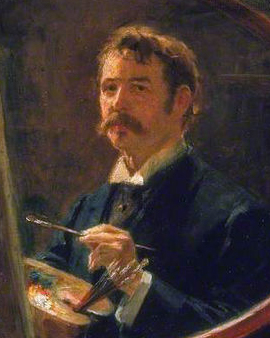


Ralph Hedley (1848 - 1913) was an illustrator, woodcarver and painter of realism. At the age of about 2 years his parents moved from Richmond to Newcastle in the course of industrialisation. Hedley began his varied artistic education at the age of 13. Hedley's father Richard was a carpenter, so it was obvious for him to learn a similar profession. While learning to carve during the day in Thomas Tweedy's workshop, he also studied art and design at the Government School and attended the evening classes of the Scottish painter William Bell Scott. Hedley was awarded a bronze medal by the Ministry of Arts and Science at the age of 14.
After graduating, Hedley opened a carving workshop that was to become very successful. He also used every opportunity he could to paint. In addition to paintings, he made illustrations, cartoons and litographs for the newspaper. The first of his many exhibited paintings was "The Newsboy", which he was allowed to present at the Royal Academy. Hedley had a strong connection to his home town. Therefore he joined forces with Henry Hetherington Emmerson and Robert Jogling and founded the Bewick Club. This was intended to provide a platform for local artists in the North East to exhibit their work. Hedley was president of the Bewick Club. He was also a highly respected member of the Royal Society of British Artists. During his career he exhibited more than 50 of his works at the Royal Academy.
Then, as now, Hedley's works are particularly appreciated for their realistic depiction of life in the North East of England between the 19th and 20th centuries. His works often showed ordinary people, workers, sailors or even veterans from his home region. Pictures like "Cat in a Cottage Window", "Going Home" or "The Tournament" are now known and popular motifs worldwide. Hedley spent his whole life in Newcastle. Even when he became a nationally known painter and artist and had an excellent relationship with the Royal Academy, he never felt the desire to move to London. His inspiration was clearly in the Northeast and especially in Newcastle. So he finally died at the age of 63 in his home town.

Ralph Hedley (1848 - 1913) was an illustrator, woodcarver and painter of realism. At the age of about 2 years his parents moved from Richmond to Newcastle in the course of industrialisation. Hedley began his varied artistic education at the age of 13. Hedley's father Richard was a carpenter, so it was obvious for him to learn a similar profession. While learning to carve during the day in Thomas Tweedy's workshop, he also studied art and design at the Government School and attended the evening classes of the Scottish painter William Bell Scott. Hedley was awarded a bronze medal by the Ministry of Arts and Science at the age of 14.
After graduating, Hedley opened a carving workshop that was to become very successful. He also used every opportunity he could to paint. In addition to paintings, he made illustrations, cartoons and litographs for the newspaper. The first of his many exhibited paintings was "The Newsboy", which he was allowed to present at the Royal Academy. Hedley had a strong connection to his home town. Therefore he joined forces with Henry Hetherington Emmerson and Robert Jogling and founded the Bewick Club. This was intended to provide a platform for local artists in the North East to exhibit their work. Hedley was president of the Bewick Club. He was also a highly respected member of the Royal Society of British Artists. During his career he exhibited more than 50 of his works at the Royal Academy.
Then, as now, Hedley's works are particularly appreciated for their realistic depiction of life in the North East of England between the 19th and 20th centuries. His works often showed ordinary people, workers, sailors or even veterans from his home region. Pictures like "Cat in a Cottage Window", "Going Home" or "The Tournament" are now known and popular motifs worldwide. Hedley spent his whole life in Newcastle. Even when he became a nationally known painter and artist and had an excellent relationship with the Royal Academy, he never felt the desire to move to London. His inspiration was clearly in the Northeast and especially in Newcastle. So he finally died at the age of 63 in his home town.
Page 1 / 1






